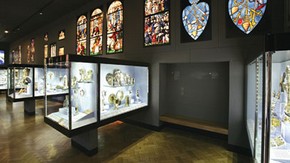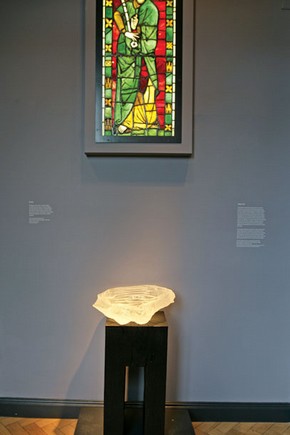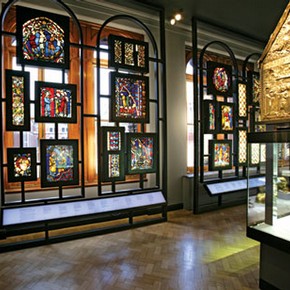Conservation Journal
Autumn 2008 Issue 56
Displaying stained glass in a museum
Stained glass is considered to be one of the more difficult objects to display in a museum, not because it needs strict environmental conditions but because it involves far more than placing it inside a case, hanging it on a wall or moving it into the correct position on the floor. The majority of the stained glass panels in the V&A's collection were originally part of a building's architecture and as such they can be large and heavy. It is not unusual for one object to consist of multiple panels that need to be supported individually. Artificially lighting stained glass at a suitable level provides a further challenge for designers because stained glass was designed to be illuminated by natural light, which changes throughout the day as well as the seasons.
Since the mid-1980s, the V&A's stained glass objects have been mounted in handmade L-section frames constructed from light aluminium alloy and painted black using a low-gloss polyester powder coating before going on display at the Museum or in external venues. The Stained Glass Conservation Studio devised these frames to protect and support the panels during installation, display, storage and transport. Their use also provides consistency for gallery and exhibition designers and enables appropriately trained technicians and curators to handle the panels safely and confidently without always requiring the presence of a stained glass conservator.

Figure 1. False wall display in the Whiteley Sacred Silver & Stained Glass Galleries (Photography by V&A Photographic Studio) (click image for larger version)
After a stained glass panel has been placed in its frame, a piece of clear Perspex® or Makrolon® is placed directly behind it to provide added support. The stained glass panel and its backing sheet are held in place with L-section brackets and screws so the frames can be removed easily without causing any stress or damage to the objects. The construction of the frame also allows for an additional piece of Perspex/Makrolon to be placed in front of the panel, which is necessary when it is displayed at a low level without a physical barrier. For irregularly-shaped panels, thin black aluminium infills are fitted under the flanges of the perimeter leads to fill the spaces between the stained glass and the rectangular frame.
False walls are often constructed for displaying stained glass in temporary exhibitions and permanent galleries. Ideally a false wall will be built far enough out from the existing gallery wall to allow the stained glass to be installed from behind it. Apertures with rebates corresponding to the dimensions of each framed stained glass panel are cut into the false wall. The framed panels are placed into their apertures from behind the false wall and held in place with wooden beading.

Figure 2. Wall-hung lightbox in the entrance of the Whiteley Sacred Silver & Stained Glass Galleries (Photography by V&A Photographic Studio) (click image for larger version)
In galleries where space is limited, like the long, narrow Whiteley Sacred Silver & Stained Glass Galleries, the false wall construction can only be deep enough to accommodate the required services and light fixtures (Figure 1). In these cases, the rebate is reversed so that the panels can be installed from the front of the false wall. Instead of using beading, a fascia board or decorative masking frame is fitted to the front of the aperture to hold the panels in the rebates. If only a few stained glass panels are to be displayed in one space, designing individual wall-hung lightboxes may be a more desirable alternative to constructing a false wall (Figure 2).
Displaying stained glass on the window side of the Whiteley Sacred Silver & Stained Glass Galleries, which overlook the John Madejski Garden, required a different solution to ensure that visitors could enjoy the views of the re-landscaped garden from these windows. A series of nine 4 metre high metal screens were designed to hold the stained glass while taking advantage of the natural light to illuminate the panels (Figure 3). The design of these screens also enabled some panels to be displayed at eye level, giving visitors the opportunity to engage with these objects at close range.
Stained glass can be illuminated artificially using either a conventional back lighting system or a slim profile edge lighting system. Variations of both were used to enhance the four different display methods chosen for the stained glass in the Whiteley Sacred Silver & Stained Glass Galleries. The stained glass panels displayed along the wall side of the gallery are backlit using fluorescent lamps. The panels displayed in the screens are individually illuminated by LED modules that switch on whenever the natural light coming through the windows needs to be boosted. An edge-lighting system using slimline fluorescent lamps was devised for the wall-hung lightboxes to enable them to be as thin as possible. Finally, the stained glass panel in the display case is edge-lit using fibre optic lighting, which is particularly good for use in enclosed spaces since it does not produce heat.
Following are some basic guidelines for artificially lighting stained glass:

Figure 3. Free-standing screens in the Whiteley Sacred Silver & Stained Glass Galleries (Photography by V&A Photographic Studio) (click image for larger version)
-
stained glass should not be lit too brightly
-
the light must be evenly distributed across the entire panel
-
the diffuser material should not have a distracting pattern that can be seen through clear, unpainted glass
-
the inside of the lightbox should be painted white to reflect the light source
-
the light source should generate a minimal amount of heat
-
suitable ventilation must be provided to dissipate heat
-
it should be possible to replace faulty lamps or transformers without having to remove the stained glass
-
the ambient light levels in the gallery should be taken into consideration to ensure too much reflected light does not fall on the stained glass
The new Medieval and Renaissance galleries, due to open in late 2009, will include over 130 stained glass objects amongst its permanent displays. The same basic display and lighting methods will be used, i.e. wall-mounted lightboxes and free-standing support structures, but no doubt with exciting new technology. Regardless of how a museum ultimately chooses to display its stained glass, the most important thing to remember is that the most successful displays will result from involving designers, engineers, conservators, curators, technicians and lighting specialists from the earliest stages of design.
Autumn 2008 Issue 56
- Editorial Comment - Conservation Journal 56
- Displaying stained glass in a museum
- Resources vs access: meeting the challenge
- Costume cleaning conundrums
- Digital Killed the Analogue Star! Care of V&A collection based carrier and machine assisted media
- Observations on the causes of flaking in East Asian lacquer structures
- Practical ethics
- Mount making for the Medieval & Renaissance exhibition tour
- SurveNIR project: non-destructive characterisation of historical paper
- The reconstruction of the materials and techniques of Nicholas Hilliard’s portrait miniatures
- Conservation of a ninth-century bowl from Iraq
- Renaissance painted cassoni
- A forthcoming technical publication of Renaissance frames at the V&A
- Conservation webs
- RCA/V&A Conservation: In-post MA for conservation professionals
- Printer friendly version